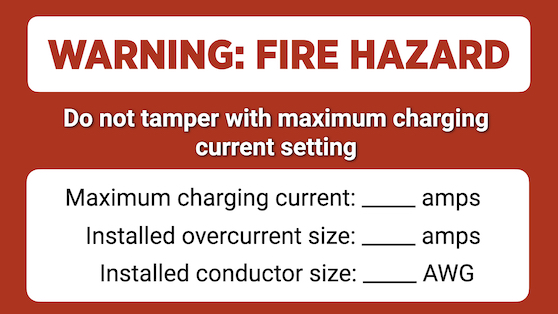
Articles
Electrified Transport
Features
Articles
Code File
Codes & Standards
Vehicles
Adjustable electric vehicle supply equipment – Code File, April 2023
April 6, 2023 | By Nansy Hanna, P.Eng.

April 6, 2023 – Different levels of government continue to support the adoption of zero-emission vehicles, with electric vehicles being the most common ZEV. If trends continue, our electrical systems must continue to evolve at every level of distribution—from the electrical grid to a home’s service panel—to meet this higher demand.
That continued evolution could involve adjustable EVSE (EV supply equipment).
Whether connecting via Ethernet or Wi-Fi, software- and app-based chargers provide the user with a greater amount of control over the charging of their EV (e.g. charging time and rate of charge), along with additional functions that allow the user to manage the load and energy consumption.
Authorities having jurisdiction (AHJs) continue to receive questions regarding software-adjustable amperage ratings of EVSE, and whether the de-rated rating can be used when determining service, feeder and branch circuit ratings.
Given that it is not directly addressed in the CE Code, let’s discuss some of the nuances of adjustable EVSE.
Based on Electrical Safety Authority Bulletin 86-1-*, it is permitted to base the rating of the EVSE on the charger’s field settings for the purposes of maximum circuit loading, disconnect requirements, or overcurrent protection—provided the adjustable settings are not accessible; meaning, a tool would be required for access.
Allowing software-adjustable settings provides advantages but, at the same time, poses some challenges. The greatest advantage is allowing the installation of the EVSE without having to incur the additional cost of upgrading the service and main panel for houses and buildings with limited loading capacities. The greatest challenge is ensuring users cannot inadvertently increase the charge rate settings, which could result in the potential hazard of a circuit overload.
To help mitigate that challenge, perhaps we consider conditions that would permit only those software-adjustable settings that support their advantages and help manage the risks, such as:
• Permitted for fixed-in-place EVSE only.
• Manufacturer’s instructions are followed.
• EVSE is marked with permanent legible marking when adjusted below the maximum nameplate rating.
• Restricted access to the adjustable settings.
CSA C22.2 No. 280 provides some helpful definitions for fixed-in-place:
• Fixed-in-place is a mounting means for EVSE that requires a tool to remove the equipment from its mounted position.
• Fastened-in-place is a mounting means for EVSE for relocation, interchangeability, maintenance, or repair without the use of a tool.
A permanent legible marking can be posted on or adjacent to the EVSE (when set below the nameplate maximum rating) with the minimum information shown in the Figure below.

Restricted access can help prevent a user from gaining unwanted access to the adjusting means, and could be accomplished by one or more of the following:
• A cover or door that requires the use of a tool for access.
• Password-protected commissioning apps or software.
• Other means by which the manufacturer can demonstrate “restricted access” has been achieved.
Some AHJs accept hardware-adjustable settings, such as dip switches but, as yet, none of them accept software-adjustable settings.
With the increase in EV charger installations—coupled with the restrictions and costs of upgrading the service capacity in older neighbourhoods (which are also the areas with the highest EV adoption)—permitting adjustable EVSE could be the obvious solution. However, this needs to be considered with clear conditions and precautions to mitigate any safety hazards to both property and personnel.

Nansy Hanna, P.Eng., is senior director, Engineering & Regulations, at Ontario’s Electrical Safety Authority. She is also chair of the Canadian Advisory Council on Electrical Safety (CACES) and a member of the ULC Advisory Council and CSA Technical Committee on CE Code-Part I.
You’ll find all Back Issues of Electrical Business Magazine in our Digital Archive.
Print this page
